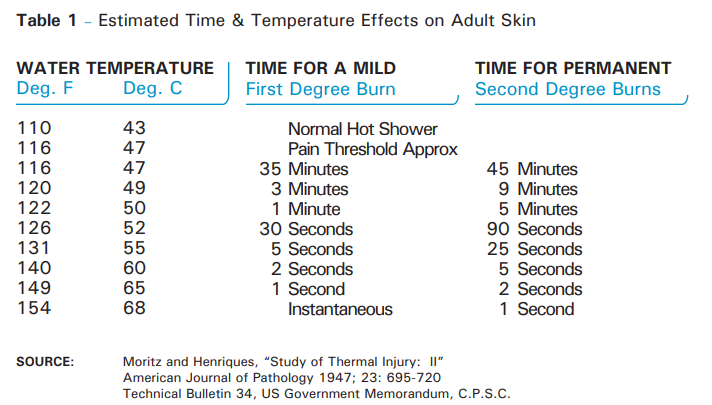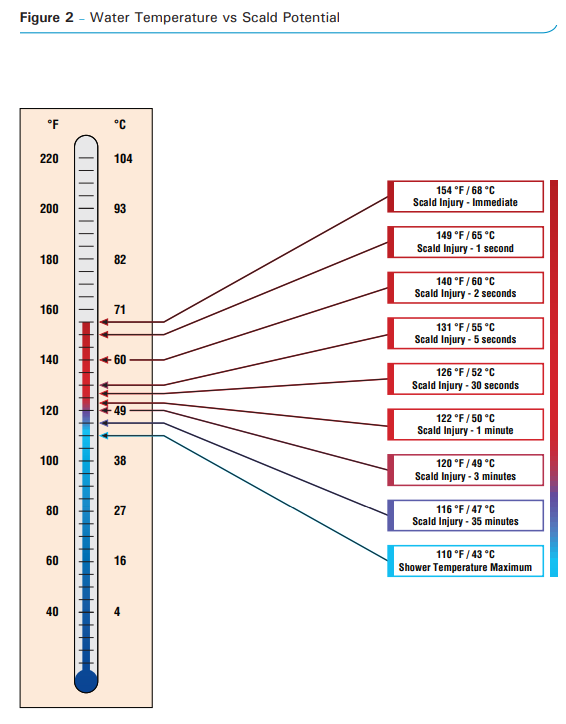Careful It’s Hot – Well, of Course It Is!

When Serving Up Safety as part of your regular foodservice, Burn Prevention should be at the top your cup. A hazard that is often overlooked or taken for granted is the elevated temperature of hot beverages such as coffee, coffee-based drinks, tea, or hot chocolate. Yes, hot beverages are supposed to be hot! But let’s take a closer look at temperature and what it can mean for workplace safety.
Hot beverages are typically what temperature?
According to the National Coffee Association, the brewing sweet spot is between 195o – 205oF. This helps to bring about a taste that is neither too sour nor too bitter. A popular single cup brewer uses water at 192oF to brew and cites typical cup temperatures of 180o – 185oF (1). One study noted 160o – 185oF as a frequent serving range, 140o + 15oF as a preferred drinking range, and proposed 136oF as an optimal drinking temperature to bridge consumer satisfaction and reduce risk of injury (2).
At what temperatures can hot drinks cause injury?
Whether you’re preparing, serving, or drinking a hot beverage, scalds occur as a function of exposure time and temperature of the liquid. To educate the public, many long-standing efforts and campaigns have preached the hazards of hot water, and, to set hot water heaters with the point-of-use temperatures in mind. Water at 120oF can be hazardous within a few minutes, or immediately inflict severe injury at 154oF (3).


There is also some evidence that chronic consumption of “very hot” beverages (140+oF) may increase the risk of esophageal cancer (4). This should not be confused with the potential health benefits and unclear cancer risks of drinking coffee (5).
How often do incidents or injuries occur?
Well, if you tend to consume these drinks, you probably already have some clue. Who hasn’t taken their first sip and had an immediate burn? You take that first sip and realize it’s way too hot and know things won’t be tasting right for a while! Or the lid on the cup isn’t quite on as it should be and your hot drink splashes all over your hand or worse, in your lap. This past year while stopping at an airport self-service kiosk, I had one of these attention-getting moments myself. I thought I secured the lid but when I picked up my cup, the lid popped off, and hot coffee washed over the back of my hand. The heat got my attention, but what was most concerning was the bright red shade my hand instantaneously turned! Ouch!!!
In 2019, hundreds of scald burns related to hot water, coffee, tea, and hot chocolates had been reported to MEMIC. The hands and fingers of servers, kitchen staff, crew members, dietary aides, and others were most commonly affected. However, feet and faces were not immune. Incidents have involved picking up and carrying cups and trays, pouring and serving, pulling cups out of microwaves, pulling coffee ground pots, and filling or handing urns, carafes, or decanters.
What actions should be taken?
Educate leaders, staff, guests, residents, and others about the facts and inherit conflicts provided here, references cited, your own safety training material.
Set clear performance expectations regarding safe methods and techniques. How to remove coffee carafes, how many full cups should be on a tray being carried through the congested dining area, and how full should cups and containers be filled are all applicable topics.
Help others recognize and communicate common warnings such as, “Caution: This beverage is Extremely Hot” so that there’s an appropriate level of attention.
Practice the common do’s and don’ts. Put cups down on a stable surface when filling them. Secure lids and minimize items handled at one time when hot drinks are involved. Use carts, let others know that hot liquids are being handled or served, and let extremely hot drinks cool before drinking them.
Develop your own specific practices based on prior incidents and conversations with staff. Train staff on department and task related hazards, and do not assume it is all common sense. Check in often so staff are certain about their practices and what’s really important. Lastly, always coach staff to positively affect their daily perceptions and attitudes. For more information check out all our safety resources at MEMIC.com.
(1) Keurig FAQs - How hot is the water in the brewer?
(2) Brown, F., and Diller, K., Burns, Volume 34, Issue 5, August 2008, Pages 648-654
(3) Understanding Potential Water Heater Scald Hazards
(4) IARC Monographs Evaluate Drinking Coffee, Mate, and Very Hot Beverages
(5) American Cancer Society - Coffee and Cancer: What the Research Really Shows

